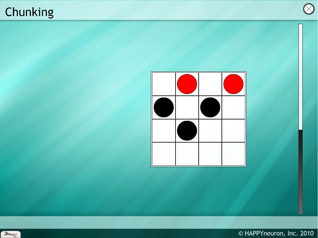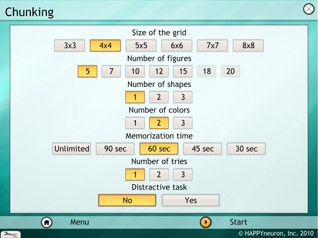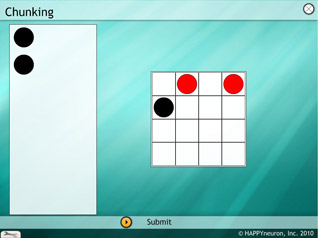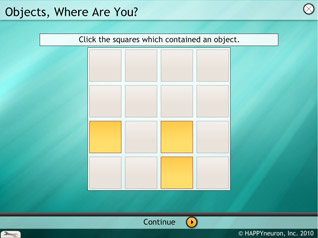Rehabilitation Program: Spatial Memory
Click to try FREE for 15-Days.
These exercises train abilities to remember locations of items using specific strategies like grouping items or defining patterns.



Chunking
The task
In this exercise, a grid is presented with several geometrical figures inside (circles or/and squares). The patient has to memorize the location of those elements and recall their position afterwards. Like all task for which it is necessary to memorize a great number of information it is essential to be used to grouping these pieces of information into individual categories or logical subcategories.
What it trains
This task trains the subject's visual and spatial perception and memory. A further aim is to practice his capacity to memorize by developing a strategy and not trying to learn by heart. Due to the vast amount of information he has to memorize, it is wiser to memorize elements by subgroups.
Parameters
The parameters that can be selected are the size of the grid (3x3, 4x4, 5x5, 6x6, 7x7, or 8x8), the number of pieces (5, 7, 10, 12, 15, 18, or 20), the number of shapes (1, 2, or 3), the number of colors (1, 2, or 3), the memorization time (unlimited, 90, 60, 45, or 30 seconds), the answer time (unlimited, 90, 60, 45, or 30 seconds), the number of tries (1, 2, or 3), and the presence or not of a distraction task (yes or no). Just one grid is presented for each series.
Number of Unique Configurations
Over 9,400 unique game configurations and significant data set depth.





Objects, Where are You?
The task
Misplaced our keys, cell phone, and notebook all in one day? This classic memory game that we all enjoy has such simple rules but it can get very challenging if we haven't played it for a while. This exercise consists in memorizing the location of several pictures on a grid, and then recalling them in the same spot as the patient has previously seen them on the grid.
What it trains
A person who lives in a big city or has ever visited one will notice the omnipresent street signs, store logos and all the various symbols on a map that one needs to know in order to find one's way. This game can also help you remember the location of various objects in a room. This exercise trains the user's visual and spatial memory and perception as it is about creating associations between two types of information, an image and its location. He'll need to build a strategy to make a comprehensive association that makes their memorization easier. He also needs to pay attention to details and stay focused on the visual and spatial information.
Parameters
The parameters that can be selected are the type of figures (objects or abstract figures), the number of figures (2, 3, 4, 5, 6, 7, 8, 9, or 10), the size of the grid (2x2, 2x3, 3x3, 3x4, 4x4, 4x5, 4x6, or 4x7), the figure memorization method (one after another, at the same time, or one by one), the memorization time per figure (unlimited, 10, 8, 6, 4, or 3 seconds) and the type of help (squares and objects, squares selected, objects selected, or no selection). The number of grids is limited to 1 for each trial. The response time per figure is unlimited.
Number of Unique Configurations
Over 10,200 unique game configurations and significant data set depth.


Click to try FREE for 15-Days.
